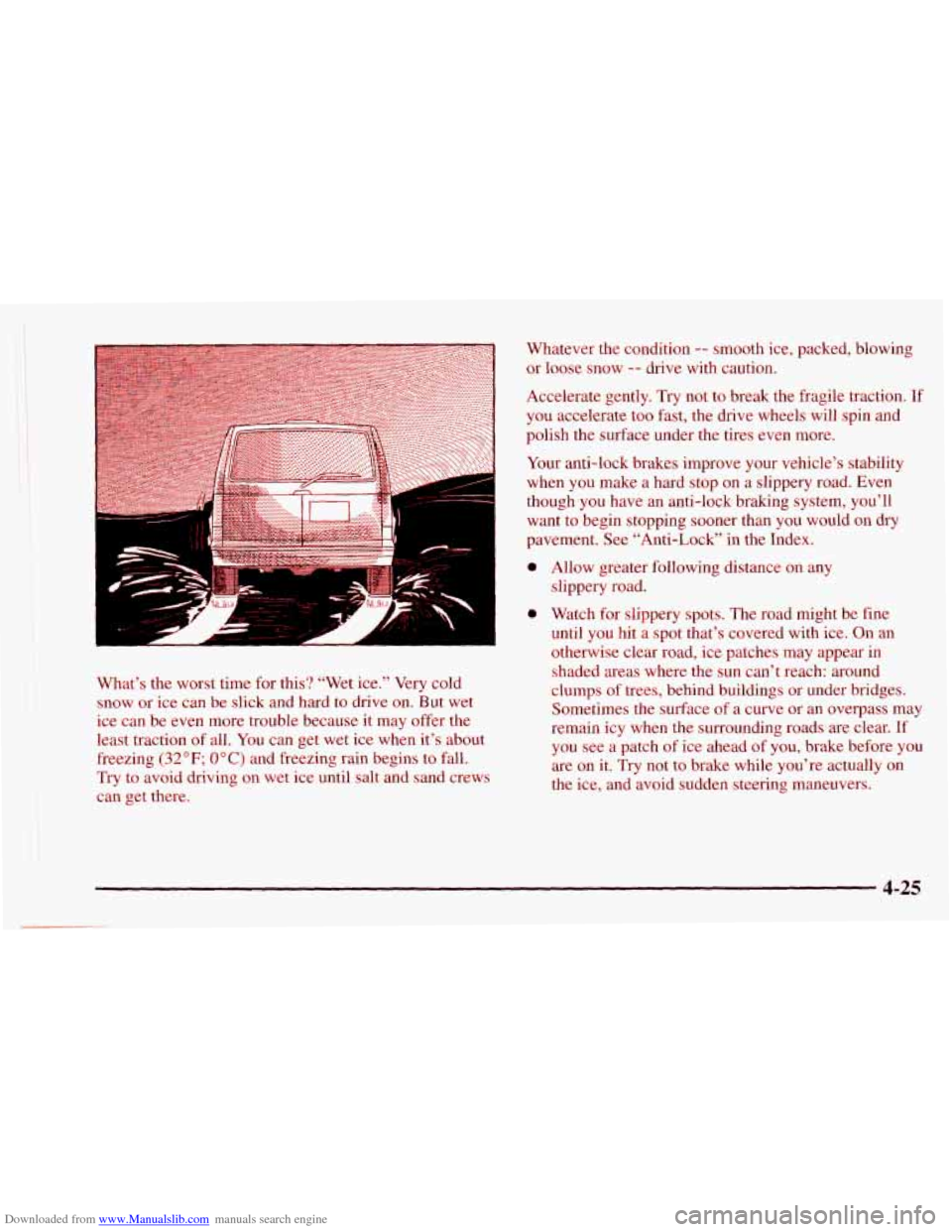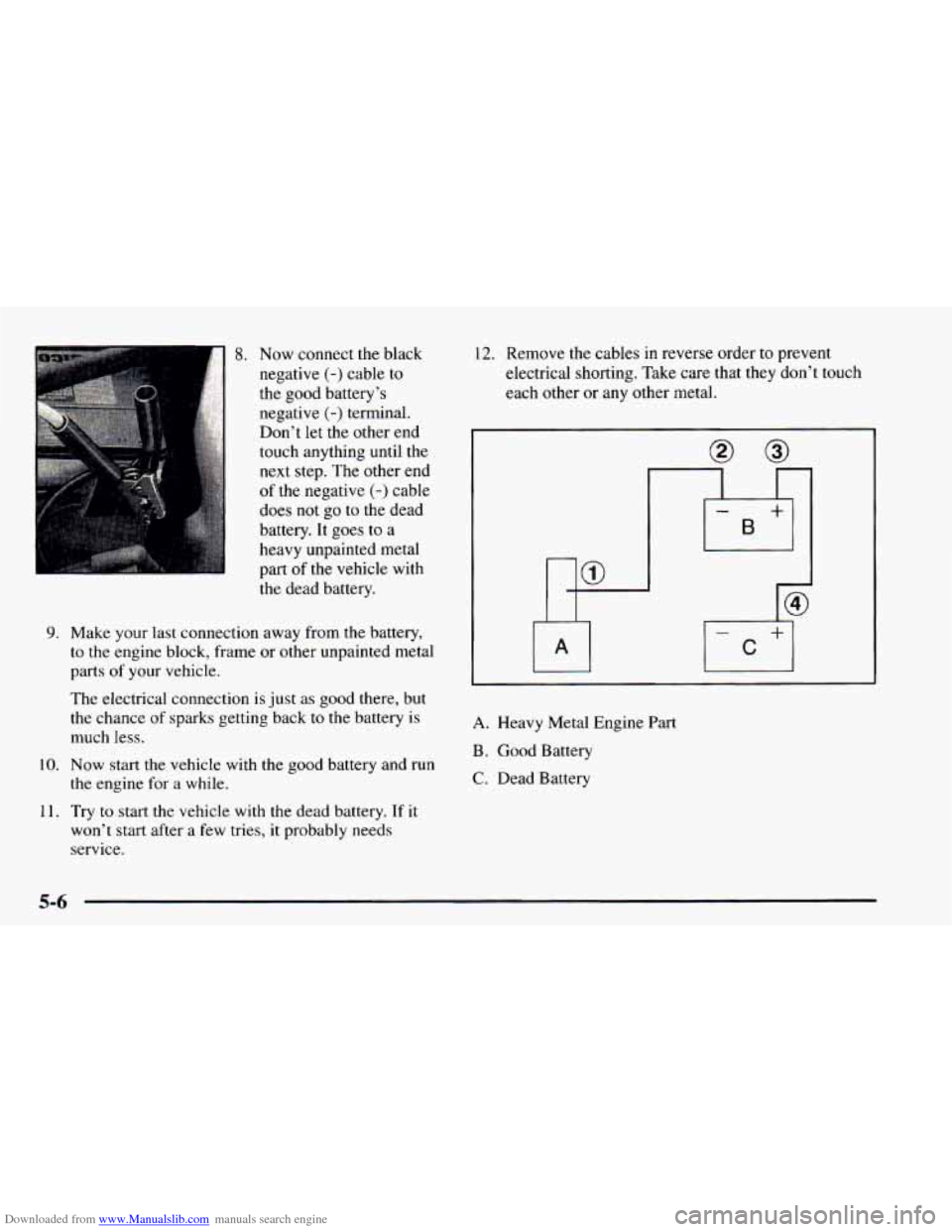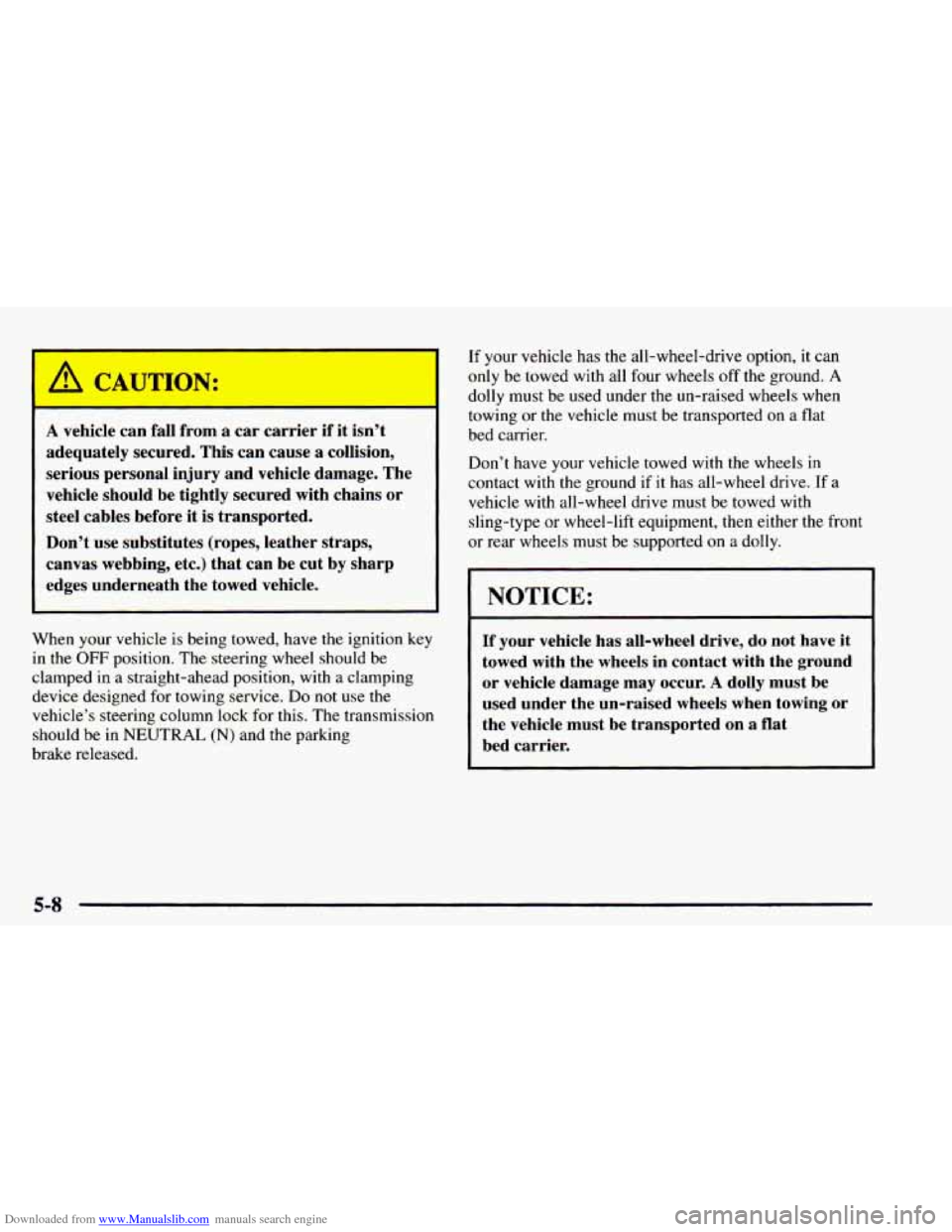Page 201 of 404

Downloaded from www.Manualslib.com manuals search engine ..... ...... ’E.. ..___.. -1 !$ .I....... ..... ....
What’s the worst time for this? “Wet ice.” Very cold
snow or
ice can be slick and hard to drive on. But wet
ice can be even more trouble because it may offer the
least traction of all.
You can get wet ice when it’s about
freezing
(32°F; OOC) and freezing rain begins to fall.
Try to avoid driving on wet ice until salt and sand crews
can get there. Whatever the condition
-- smooth ice, packed, blowing
or loose snow -- drive with caution.
Accelerate gently.
Try not to break the fragile traction. If
you accelerate too fast, the drive wheels will spin and
polish the surface under the tires even more.
Your anti-lock brakes improve
your vehicle’s stability
when
you make a hard stop on a slippery road. Even
though you have an anti-lock braking system, you’ll
want to begin stopping sooner than
you would on dry
pavement. See “Anti-Lock” in the Index.
a
a
Allow greater following distance on any
slippery road.
Watch for slippery spots. The road might be fine
until you hit a spot that’s covered with ice. On an
otherwise clear road,
ice patches may appear in
shaded areas where the sun can’t reach: around
clumps
of trees, behind buildings or under bridges.
Sometimes the surface of a curve or
an overpass may
remain icy when the surrounding roads are clear. If
you see a patch of ice ahead of you, brake before you
are on it. Try not to brake while you’re actually on
the ice, and avoid sudden steering maneuvers.
4-25
Page 203 of 404

Downloaded from www.Manualslib.com manuals search engine This can cause deadly CO (carbon monoxide) gas
to get inside.
CO could overcome you and kill
you.
You can't see it or smell it, so you might not
know
it is in your vehicle. Clear away snow from
around the base
of your vehicle, especially any
that
is blocking your exhaust pipe. And check
around again from time
to time to be sure snow
doesn't collect there.
Open
a window just a little on the side.of the
vehicle that's
away from the wind. This will help
keep
CO out.
Run your engine only as long as you must. This saves
fuel. When you run the engine, make it go a little faster
than just idle. That is, push the accelerator slightly. This
uses less fuel for the heat that you get and it keeps the
battery charged. You will need a well-charged battery to
restart the vehicle,
and possibly for signaling later on
with your headlamps. Let the heater run for awhile.
Then, shut the engine
off and close the window almost
all the way to preserve the heat. Start the engine again
and repeat this only
when you feel really uncomfortable
from the cold. But do it as little as possible. Preserve the
fuel as long as you can.
To help keep warm, you can get
out
of the vehicle and do some fairly vigorous exercises
every half hour or
so until help comes.
4-27
Page 224 of 404

Downloaded from www.Manualslib.com manuals search engine 1 8. Now connect the black
negative
(-) cable to
the good battery’s
negative
(-) terminal.
Don’t
let the other end
touch anything until the
next step. The other end
of the negative
(-) cable
does not
go to the dead
battery. It goes to a
heavy unpainted metal
part of the vehicle with
the dead battery.
9. Make your last connection away from the battery,
to the engine block, frame or other unpainted metal
parts
of your vehicle.
The electrical connection is just as good there, but
the chance of sparks getting back to
the battery is
much less.
10. Now start the vehicle with the good battery and run
the engine for a while.
11.
Try to start the vehicle with the dead battery. If it
won’t start after a few tries, it probably needs
service.
12. Remove the cables in reverse order to prevent
electrical shorting. Take care that they don’t touch
each other or any other metal.
A. Heavy Metal Engine Part
B. Good Battery
C. Dead Battery
5-6
Page 226 of 404

Downloaded from www.Manualslib.com manuals search engine A vehicle can fall from a car carrier if it isn’t
adequately secured. This can cause a collision,
serious personal injury and vehicle damage. The
vehicle should be tightly secured with chains
or
steel cables before it is transported.
Don’t use substitutes (ropes, leather straps,
canvas webbing, etc.) that can be cut by sharp
edges underneath the towed vehicle.
When your vehicle is being towed, have the ignition key
in the
OFF position. The steering wheel should be
clamped in a straight-ahead position, with a clamping
device designed for towing service.
Do not use the
vehicle’s steering column lock for this. The transmission
should be in
NEUTRAL (N) and the parking
brake released.
If your vehicle has the all-wheel-drive option, it can
only be towed with all four wheels off the ground.
A
dolly must be used under the un-raised wheels when
towing
or the vehicle must be transported on a flat
bed carrier.
Don’t have your vehicle towed with the wheels in
contact with the ground if it has all-wheel drive. If a
vehicle with all-wheel drive must be towed with
sling-type or wheel-lift equipment, then either
the front
or rear wheels must be supported
on a dolly.
I NOTICE:
If your vehicle has all-wheel drive, do not have it
towed with the wheels in contact with the ground
or vehicle damage may occur. A dolly must be
used under the un-raised wheels when towing or
the vehicle must be transported on a flat
bed carrier.
Page 237 of 404
Downloaded from www.Manualslib.com manuals search engine How to Add Coolant to the radiator
1. You can remove the
radiator pressure cap
when the cooling system, including the
radiator pressure cap and
upper radiator hose, is
no longer hot. Turn the
pressure cap slowly
counterclockwise until it
first stops. (Don’t press
down while turning the
pressure cap.)
If you hear a hiss, wait for that to stop. A hiss means
there is still some pressure left.
I
2. Then keep turning the
pressure cap, but now
5-19
Page 241 of 404
Downloaded from www.Manualslib.com manuals search engine Changing a Flat Tire
If a tire goes flat, avoid further tire and wheel damage
by driving slowly to
a level place. Turn on your hazard
warning flashers.
I A CAUTION:
I
Changing a tire can cause an injury. The vehicle
can slip
off the jack and roll over you or other
people.
You and they could be badly injured.
Find
a level place to change your tire. To help
prevent the vehicle from moving:
1. Set the parking brake firmly.
2. Put the shift lever in PARK (P).
3. 'hrn off the engine.
4. Put the wheel blocks at the front and
rear of the tire farthest away from the
one being changed. That would be the
tire on the other side of the vehicle, at
the opposite end.
The following steps will tell you how to use the jack and
change
a tire.
5-23
Page 242 of 404
Downloaded from www.Manualslib.com manuals search engine Removing the Spare Tire and Tools
The jacking equipment you’ll need is stored by your
vehicle’s rear doors, along the passenger side wall.
Remove your jack cover by pulling it away from the
side wall and down
to release the tabs securing the top
of the cover. Remove the wheel blocks
by turning the top nut
counterclockwise. Remove the nut and washer, then pull
the wheel blocks off the bolt. Push down on the bolt and
remove
the hooked end from the slot. Slide the jack
toward the front
of the vehicle and lift it from the
mounting. Remove the extension and
the ratchet from
the pouch.
5-24
Page 244 of 404
Downloaded from www.Manualslib.com manuals search engine Put the flat end of the extension on an angle through the
hole in the rear door frame, above the bumper. Be sure
the flat end connects into the hoist shaft.
Turn the ratchet counterclockwise to lower the spare tire
to the ground. Keep turning the ratchet
until the spare
tire can
be pulled out from under the vehicle. When the
tire has been
lowered,
tilt the retainer at
the end
of the cable and pull
it through the wheel opening.
Pull the tire out from under the vehicle.
I NOTICE:
To help avoid vehicle damage, do not drive the
vehicle before cable is restored.
5-26